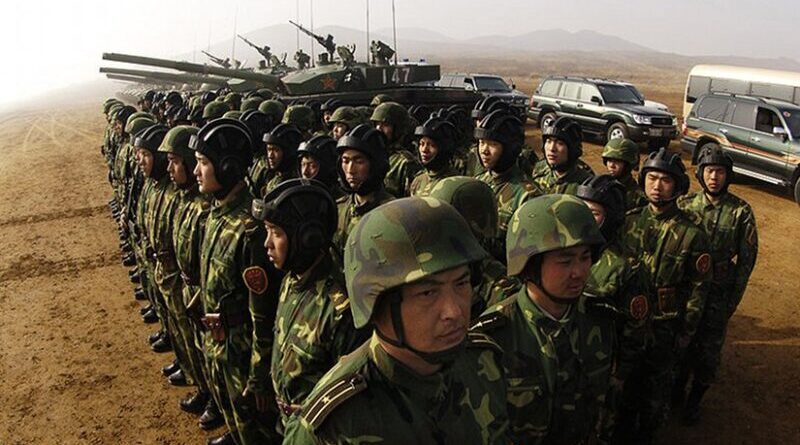China’s Military: The Shape Of Things To Come – Analysis
By Observer Research Foundation
By Harsh V. Pant
With China aiming to develop a “world-class” military by 2050 that can fight and win wars across all theatres, Indian conventional and nuclear thinking will also have to evolve Xi Jinping ordered the People’s Liberation Army (PLA) to be ready for battle, as the country in his opinion faces unprecedented risks and challenges. He said “all military units must correctly understand major national security and development trends, and strengthen their sense of unexpected hardship, crisis and battle.”
Underlining that “the world is facing a period of major changes never seen in a century, and China is still in an important period of strategic opportunity for development,” Xi stressed the need to focus on combat research, advance work in all areas and accelerate the development of strong and efficient “joint-operation commanding institutions for theatre commands to comprehensively boost the military’s battle-winning ability.”
Xi also signed a mobilisation order for the training of the armed forces, the CMC’s first order of the year, which requires all units of the PLA “to welcome the 70th anniversary of the founding of the People’s Republic of China with ‘excellent performance’.”
Xi has been a great enthusiast for the Chinese military’s proactiveness, and ever since assuming office, has been pushing the PLA to boost its combat-readiness. He told the Communist Party’s 19th Party Congress in 2017 that China will complete the modernisation of its armed forces by 2035, and achieve a “world-class” military by 2050, that can fight and win wars across all theatres.
Last year Xi ordered the military region responsible for monitoring the South China Sea and Taiwan to assess the situation it is facing, and boost its capabilities so it can handle any emergency. It has been reported that about two million personnel were involved in more than 18,000 mostly small-scale exercises in 2018, compared to just 100 such exercises in 2016.
For Xi and China, military modernisation is top priority as the international environment enters uncharted waters. But more than that, it’s the effective integration of force into foreign policy-making that is now becoming the norm, and is a cause of concern for other states. Tensions between the US and China are gathering pace and show no sign of abating. The Donald Trump Administration is not letting up the pressure it has mounted on Beijing, with US Vice-President Mike Pence charging recently: “Using that stolen technology, the Chinese Communist Party is turning ploughshares into swords on a massive scale.”
Acting US Secretary of Defence Patrick Shanahan told the US military leadership to remember “China, China, China,” singling out Beijing as a key priority in emerging great power competition.The US Navy continues to conduct freedom of navigation exercises in the South China Sea region.
The Chinese response is getting shriller, with Beijing revoking permission for a US warship to visit Hong Kong and recalling its key naval official from Washington. China has taken strong exception to US sanctions on its buying of weapons from Russia and Washington’s stepped-up rhetoric on Taiwan. Recently, Xi called on Taiwan to reject moves towards formal independence and embrace “peaceful reunification” with his country, in line with the concept of “one country, two systems” used in Hong Kong when China regained sovereignty over the city from the UK in 1997. Xi did not rule out using military force to take Taiwan.
The Chinese leader has in the past vowed not to cede “a single inch of our motherland”, and has increased military exercises around Taiwan. Taiwanese President Tsai Ing-wen rejected Xi’s “one country, two systems” suggestion outright, underlining that Taiwan’s priorities in 2019 include protecting its democracy and safeguarding its sovereignty, in addition to improving people’s livelihoods.
In the face of an economic downturn back home and growing pressures abroad, Xi is using military rhetoric to shore up his credibility in the eyes of his domestic constituencies. But it is also a fact that China’s military modernisation is beginning to pay dividends, with the gap between the US and Chinese militaries getting narrower.
While the US Navy remains technically more advanced, the PLA Navy (PLAN) is catching up. New stealth fighters and long-range bombers have been brought into service and Chinese warships are gearing up with advanced radars and control systems. Earlier this month, China showcased a new type of massive aerial bomb as its response to America’s “Mother of All Bombs”, the most powerful non-nuclear weapon. The Chinese weapon is said to be smaller and lighter than the American version. China is moving rapidly, emerging as a frontline state in cutting-edge defence technologies, which will have grave implications for the technological balance of global power.
Indian military modernisation is also progressing but moving in fits and starts. A cohesive strategy is still not visible, especially in the context of challenges that China is posing from across the border. As global military thinking rapidly undergoes a shift, Indian conventional and nuclear thinking will also have to evolve. Old certitudes will no longer apply.
This article originally appeared in Business Standard.

